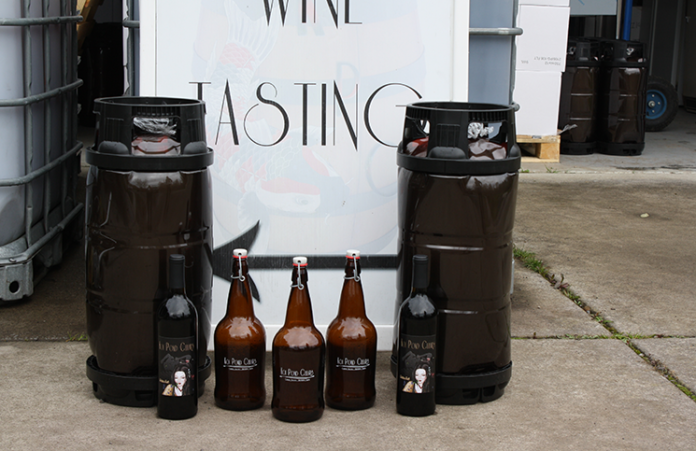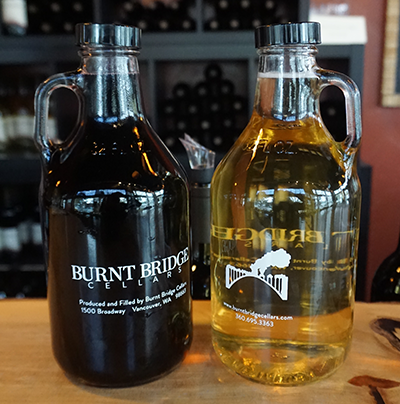
Keg wine began showing up in restaurants years ago but it wasn’t immediately embraced. The quality of the wines and breaking down conceptual barriers took some time.
Fast forward to 2018 and the environmental aspect of keg wines has a fan base lifting a glass to packaging that had been reserved for beer.
Close to home, local wineries are embracing keg systems and there are benefits being passed on to consumers as a result.
According to Mark Mahan, co-owner of Burnt Bridge Cellars in downtown Vancouver, because keg wine is still a fairly new concept, there aren’t many standard systems, and those that do exist are pricey. As a result, large wineries like Waterbrook and Wilridge have been at the forefront of wines on tap.

At Burnt Bridge, the team has been using kegs for years to hold wine and top off barrels as some is lost through the “Angel’s Share” or evaporation. Around Christmas of 2017, Mahan decided to route a delivery system through the wall between their barrel room and tasting room to create a formal three-tap system. This keeps their wines fresher longer and saves on wine spoilage from bottles left open for more than a couple days.
The second piece to their idea is “howlers,” customized Burnt Bridge Cellars 32-ounce bottles that are about half the size of beer growlers. This gives customers approximately one more glass of wine than a standard 750 ml wine bottle. Since employing their wine-on-tap system, Burnt Bridge has quadrupled their howler sales.
“It’s a lot of fun and people enjoy it,” Mahan said. “It’s a cool thing. We have about a dozen customers who come in with their howler looking for a new refill. It’s a good weekend size.”
The plan is to keep two reds and one white on tap, rotating the selection for variety and feature new releases as those become available. Flagship reds will remain bottle-only purchases to preserve the integrity of higher-end wines.
Mahan sees keg wine giving their winemaker, Ben Stuart, more creative license. Without wine labels that must go through a series of requirements with the TTB (Alcohol and Tobacco Tax and Trade Bureau), he can offer slightly different blends than what is available in bottle, mix one vintage with another and experiment in other ways while maintaining the level of quality that Burnt Bridge is known for.
Less packaging equals a cost savings for patrons. Burnt Bridge is aiming to offer their howlers at $5 less than bottle prices. They’re hoping that savings will also make them more competitive in the restaurant market.
“They (area restaurants) are interested because it’s a cost savings and a waste savings,” Mahan said. “Restaurants can now serve a really nice glass of wine for $10 instead of a middle of the road wine. It breaks that difficult barrier of ‘I have to recoup my investment with the first glass.’”
Ridgefield winery Koi Pond Cellars is selling two of their wines wholesale in 100 percent recyclable plastic kegs. Die-hard fans can pick up a keg, but since it holds 112 glasses of wine, that option is not viable for most personal consumption scenarios. Come the end of May, however, their Signature Steel-aged Chardonnay and Signature Merlot will be available on tap when their downtown wine bar opens, and they are considering to-go growlers as well.
Owners Wes and Michelle Parker saw the on-tap wine concept at Waterbrook back in 2013 and have wanted to employ it at Koi Pond ever since. The stigma of keg wine equaling a lesser quality wine is gradually dissipating, and Michelle sees keg wine as a great everyday drinking wine that’s less expensive, friendlier to the environment, and reduces waste and saves time in the restaurant environment.
It was a business decision that required some research. Each winery has a different take on nitrogen versus argon to top off their kegs. In the end, it comes down to personal preference and price point from the supplier. Koi Pond found that the metal lining in steel kegs affect the flavor of red wines slightly and since the plastic ones do not require a keg deposit for restaurants that was another bonus. Wine must be delivered into kegs via a pump, which can be a harsh treatment for the liquid. Therefore, a few different pumps were trialed to come up with the one they felt was the most delicate and then give the kegs extra time to “calm down.”
“It’s new to a lot of patrons,” Michelle said. “We’re breaking down stereotypes and just a sample will change your mind. Keg wine is quite the value, especially with the steel-aged chardonnay.”
Heathen Estate offers most of their wines on draft at their downtown affiliate, Heathen Brewing Feral Public House. They keg in stainless kegs just like beer and push the wine through with nitrogen. Although they do not offer growlers to go yet, they are bottling to-go wines in 500 ml beer bottles and topping them with nitro to preserve the wine.
“Offering wine on draft was more about not letting beautiful wines go bad or to waste,” said Sunny Parsons, owner of Heathen. “The keg allows a fresh wine even after months of being on draft.”
Soon, Rusty Grape Vineyards will join the ranks of the wine-on-tap group in Clark County. Plans are in motion to expand their tap system from six to 18 to accommodate a growing cider program, but two taps will be reserved for their Recession Red and Sweet Riesling. The on-tap wines will be poured at a reduced price and a carafe of wine can be ordered similar to the way wine is served in osterias and trattorias in Europe.


